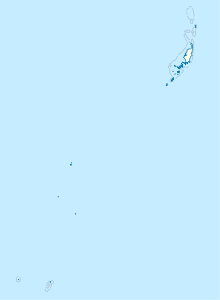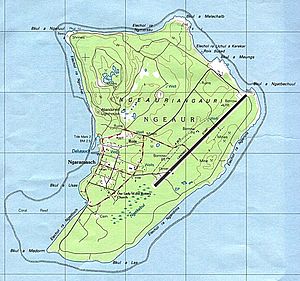Angaur
| Angaur | ||
|---|---|---|
| NASA satellite image | ||
| Waters | Pacific Ocean | |
| Archipelago | Palau Islands | |
| Geographical location | 6 ° 54 ′ 0 ″ N , 134 ° 8 ′ 0 ″ E | |
|
|
||
| length | 4.3 km | |
| width | 3.5 km | |
| surface | 8 km² | |
| Residents | 119 (2015) 15 inhabitants / km² |
|
| main place | Ngaramash | |
| Map of Angaur | ||
Angaur (also Ngeaur , Jap. アンガウル angauru ) is the South Pacific island nation of Palau is part of the island . The island belongs to the Palau administrative area of the same name, Angaur .
The lush, sparsely populated and hardly 8 km² island represents the southern end of the Palau Islands . In 2005, around 320 people lived on Angaur, in 2015 only 119 people, mostly in the main village Ngaramasch (formerly Saipan Town ) on the west coast. Immediately east of Ngaramasch is the second village on the island, Rois . To the northeast is the abandoned village of Gabayanga . The highest point of the 3.9 × 2 km large island is the 40 m high Ramuldo Hill.
The most important branches of industry are agriculture , fishing , phosphate mining and tourism. In addition to Palaui and English , Japanese is the official language on Angaur .
history
In 1899 Angaur became part of the German New Guinea colony together with the rest of the Palau Islands . At the beginning of the First World War , the island was occupied without resistance. On September 26, 1914, the Australian cruiser Sydney arrived. The landing party of the cruiser confiscated only the radio equipment of the German station. This happened in such a hurry that the radio station could reasonably be restored by the islanders after the ship had left. Angaur was finally occupied by Japanese units on October 9, 1914 .
During World War II , a battle between US and Japanese troops took place on Angaur . The two-kilometer-long paved runway in the east of the island also dates from this time .
From German times only the remains of a destroyed phosphate conveyor system are preserved.
Monkey plague
There is currently a plague of monkeys on Angaur Island. Numerous long-tailed macaques inhabit the island. The origin of the macaques is debated. But they should come from a single couple from the German colonial times. The neozoa have no natural enemies on Angaur. After years of striving to exterminate the monkeys, a sanctuary was announced in the northwest of the island in 2019, which should also be accessible to visitors.
See also
Individual evidence
- ↑ www.statoids.com
- ^ Constitution of Angaur State
- ↑ Golf Dornseif: Pioneering Years of Colonial Telegraphy Connections, p. 15 (pdf; 2.2 MB) ( Memento of the original from October 15, 2013 in the Internet Archive ) Info: The archive link was inserted automatically and has not yet been checked. Please check the original and archive link according to the instructions and then remove this notice.
- ↑ Steffens discovers ... Palau - coral paradise of the South Seas ; accessed on May 3, 2019.
- ↑ Abstract of a scientific article on ResearchGate ; accessed on May 3, 2019.
- ↑ Newspaper article in the Island Times from Palau ; accessed on May 3, 2019.



